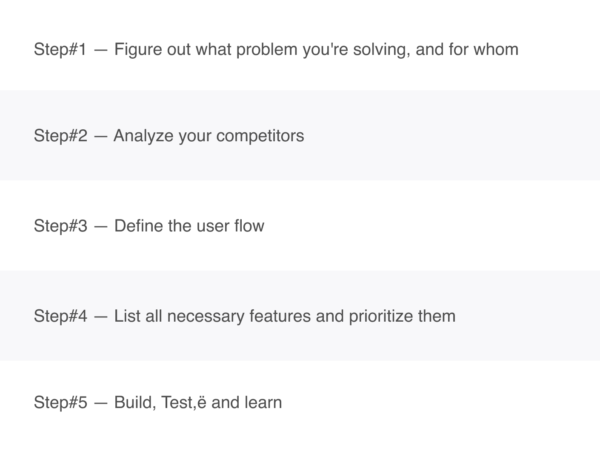Viernes, 28 octubre 2022
The UX Process for Information Architecture
For example, you can ask them to look for specific information (e.g., contact or payment details, certain item for sale, etc.) or perform a specific task (e.g., register a new account, complete a purchase, etc.). Obviously, they can’t find the answers as the content is not ready yet, but they can still indicate their course of action while interacting with your future product. The cards can be digital or physical, i.e. written on pieces of paper. They should have numbers and some should have blank spaces, so the participants can create their own names for categories.

“The need for talent will increase in parallel especially for individuals with a dual technology and business skill set,” he says. When users do find what they want, good information architecture design can help them find information architecture web design additional context and information that they need to make a choice, such as nutritional information or user reviews. Ramotion is an award winning design agency with more than 10 years of experience in the industry.
What Is Information Architecture, and Why Is It Important?
Regardless of where they work, information architects typically spend most of their time in front of a computer, using various software tools to design, test, and analyze digital content. Even though the IA itself isn’t visible in the UI, it most definitely impacts the User Experience (UX). As we know from the definition of user experience, the total user experience is built up from everything the user encounters. And while users don’t see the structure of the website, they will hopefully get the feeling that content is divided up and connected in ways that match their needs and expectations. Sadly, of course, users leave many sites feeling that the content/functionality was not what they wanted and they experience friction because of poor organization, structure and/or nomenclature. Depending on the sort of website or application being created, information architecture can change.

And U.S. governments offer templates, and UX research organizations like the Nielsen Norman Group offer guidance, but typically site creation happens organically. Information Architecture takes a good deal of mental work, and so some IAs prefer to use nothing but paper and pen. However, https://www.globalcloudteam.com/ ultimately, information architecture results in site map creation, metadata tagging, and categorization—all of which needs to be shared with clients in one visual format or another. Some information architects also create site wireframes, which require additional tools.
Labeling systems
Results might show chronologically by date, alphabetically by title or author, or based on popularity. Based on user research and content inventory, determine the main information categories and how they relate to each other. Consider creating a visual sitemap or hierarchical diagram to outline the structure and relationships between different sections. These principles serve as guidelines to create effective information architectures that enhance usability, navigation, and findability, resulting in a positive user experience. Put the needs and goals of the users at the center of the information architecture design.

A commuter reading a mobile screen on a subway train, for example, has a far different experience than a Kindle reader lying in bed at night. This is particularly likely to happen when the designer is the one responsible for doing the information architecture work. Since designers tend to think visually, it makes sense for the designer to use wireframes to demonstrate the hierarchy of information. Wireframes are also a valuable deliverable to share with clients, and for developers and visual designers to reference as they build mockups, prototypes, and final products. Every website or app needs a solid navigation system that helps users find what they need. As soon as you have the results of card sorting activities, you will understand how to embody and classify the content in reality.
Unlock your business potential with us
Information architecture is a website, library, or store of a concrete foundation to a house. Most information architects have bachelor’s degrees, but salaries increase with higher degrees. Certifications can also increase earning power, including those in usability or project management. Because of this, information architecture skills are in high demand across a wide range of industries. ZipRecruiter, for example, currently lists more than 200,000 information architect jobs. The broad topic of “health” welcomes the users, while a page about “individual health insurance” would have specific content for a singular topic or issue.
- Creating a good information architecture is key to a good user experience — you can’t have one without the other.
- Here are some commonly recognized IA guidelines that help UX designers achieve the best usability and experience.
- Consider creating a visual sitemap or hierarchical diagram to outline the structure and relationships between different sections.
- That means you don’t get the product you wanted and that company doesn’t get your business.
- He is an accomplished technology leader with a 25+ year track record of delivering technology transformation programs spanning both application and infrastructure domains.
- If content is king, user experience is a big fat queen; and they live in a castle built on information architecture.
The information architect is the one who needs to handle these questions and decide what the next move is in terms of IA design. These questions mostly refer to the audience, because the IA design is directly influenced by it. Information Architecture influences everything, so it’s best to have a big picture in mind before getting to work. This is a mistake because efficient navigation is not possible without a good Information Architecture foundation. In this experiment, provide participants with a simplified version of your website structure, forming a map connecting all your pages in a tree-like structure. Ask them to complete certain tasks using this, and note if they struggle when trying to complete a task.
How much money does an information architect make?
Additionally, a well-planned information architecture facilitates the creation of targeted and relevant content, aligning with user needs and improving SEO efforts. The information architecture process is fundamentally one of avoiding the particular while insisting on the general. At various points in this conceptual phase, stakeholders, clients, and even members of your design team may find it irresistible to launch into specific proposals for the visual design of pages. Visually plain page wireframe diagrams force teams to stay focused on the information architecture and navigation vocabulary without getting sidetracked by the distraction of purely visual design. This communications role is crucial throughout the project, as the site diagram evolves in iterations from a brainstorming and planning document into a blueprint for the actual site as it will be developed.
This includes user research, such as user testing and interviews, to understand user needs and behaviors, as well as data analysis to understand patterns in user behavior. They also create diagrams and models, such as site maps, user flows, and wireframes, to visualize the information structure and how users will interact with it. While the definition of information architecture is relatively well-established in the field of systems design, it is much more debatable within the context of online information(i.e., websites). In the big IA view, information architecture involves more than just the organization of a website; it also factors in user experience, thereby considering usability issues of information design. To mitigate these consequences, it is crucial to invest in thoughtful information architecture design that prioritizes user needs, clear organization, and intuitive navigation.
Data architecture vs. information architecture
If you deviate from that pattern, make sure you have a very good reason to do so; and make the deviation is consistent in similar cases. A main page with subpages is probably the most commonly seen website IA pattern. This consists of a main page (we know this more commonly as a “homepage” or “front page”), which serves as a jump-off point for all the other pages. IA, UX, and UI are closely related and sit under the umbrella of product design concepts, but they are not the same.
While this article has covered the history, concepts, techniques and technology behind information architecture, it has really only scratched the surface. IA is a very broad topic with lots of literature for both newcomers and experienced architects. For lots more information, be a part of this site’s user interaction IA and click forward to the next page. Review it first and decide what to keep and get rid of if the website already has content. Finally, good information architecture design should also ensure that, if a user previously found something on the site, they can easily find it again.
Use the best information architect tools
The participants are given predefined categories from a content inventory list, and they sort the content according to them. UX or user experience is what users feel when they interact with the product. So, the aim of UX design is to make a product practical, useful, attractive, and so on — in other words, to create a positive experience from using it. It handles the chaos, creating a clear structure for a website, an app, or a program. In this article, we’ll explain how you can build superb information architecture. The information architecture culture seems to have emerged out of the explosive growth of the Web in the 1990s combined with the publishing of Richard Saul Wurman’s book “Information Architects” in 1996.